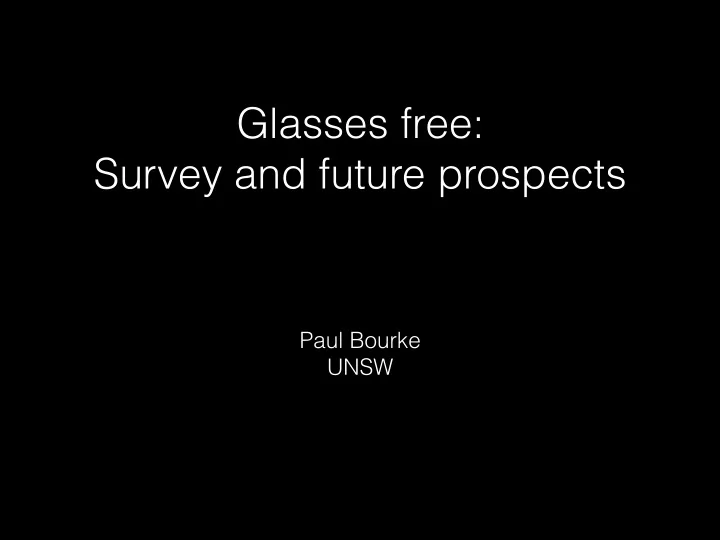

Glasses free: Survey and future prospects Paul Bourke UNSW
Introduction Simulated depth perception, largely through stereoscopy has been a standard • technique throughout the history of data visualisation. Assisting in the understanding of geometrically complicated data. In the rush towards commodity stereoscopy (glasses based) and head mounted • displays, it is worth (re)exploring auto stereoscopic technologies. There was a autostereoscopic peak in the late 1990s. • A large number of lenticular display products appeared on the market. Questions • - Are there advances that make existing stereoscopic displays more viable, particularly higher resolution panels? - Are there any new technologies on the horizon?
Plenoptic function Adelson and Bergen developed the concept of the plenoptic function. • A description of the light passing through a point in space and time. • For an observer it is a function of position (where the field is being observed) and the • direction from which the light approaches this position. Autostereoscopic displays can be rated according to how well they approximate the • plenoptic function, typically the degree to which it is being sampled. In an ideal display each element would consist of multiple directional emitters, in the • synthetic holography world this wavelength and direction vector is referred to as a hogel.
Holography: The most abused word
Peppers ghost
Barrier strip Simplest to explain and there is a straightforward extension to lenticular and • requirement of all auto stereoscopic displays. Only require two images (has advantages and disadvantages). • Requires very precise head positioning, or very precise head tracking. • Suited to print and digital display. • Sharp SH25LiS 2002 Fujifilm Finepix Real3DW3
Multiplexed image Stereo pair Left Right Multiplexed image
Multiplexed image Left Right eye eye
Multiplexed image Left Right eye eye
Multiplexed image Left Right eye eye
Example: No-name (Android) tablet Based upon a 2600 pixel • (horizontal display). Uses a front LCD layer to act as • the barrier, so can be used as a normal 2D panel at full resolution. This is at one end of the scale, • highest resolution but only a single view position.
Lenticular Replace barrier strip with a lens array, elements called “lenticules”. • Possible to create precise low cost lens strips. • Suited to both print and digital displays. • Number of images depends on the resolution of the underlying media. • Typically 8-16 for displays, 30-50 for print. Images captured along a linear track, any pair is a stereo pair. • Will benefit from increased display resolution. •
Multiplexed image Lenticular lens
Lenticular prints
Example: Alioscopy 4K Alioscopy released a version of their product early in 2015. • Based upon a 4K panel. • Supports up to 8 images. • Lenticular screen is layered on front and exposed, could get damaged. • Note that effective resolution is not 1/N due to a slanted lenticular array with respect • to the LCD elements. ( Berkel, Parker, Franklin, “Multiview 3D LCD,” Proc. SPIE 2653, 32 (1996)
Comments Great improvement over previous HD resolution versions. • Depth budget is still very low and thus not suited to VR applications. • Viewer still needs to be located too far from the display. • Solution requires either - variable spaced lenticules - variable spaced LCD elements (not possible as based upon existing panel) and market too small. Effective resolution still relatively low despite being based upon a 4K panel. • Not aware of ay 8K version in development.
Synthetic (light field) holograms Based upon film resolution recording of “hogels”, generally recorded with • photopolymers. Realtime based upon micro-mirror arrays. Pioneered by Geola, USA representation is Zebra print. • Typically create >1000 renders as an approximation to the light field. • Possible to create parallax in two dimensions for images that can be viewed from all • directions. Unlike true holograms where colour fidelity is difficult, these are full colour. • Supply images from a render process, or the model for the supplier to render. • Expensive, ~$1000 for A4 size. Been that way for over 6 years. •
Example: Geola
Summary Barrier strip tablet Lenticular 4K panel Lenticular print Synthetic hologram Contributing images 2 5 - 8 ~40 ~1000 (x1000) Viewing distance (mm) ~400 ~2000 500+ ~800 Viewing angle Narrow precise ± 5 ± 15 Widest ± 45 (degrees) position Dimensions (width, ~120 ~700 ~500 ~400 mm) Controlled lighting No No No Yes Dynamic/realtime Yes Yes No Difficult Perceived resolution High Modest Good Modest Depth budget Limited Limited Good Good Photography capable Yes Yes Yes Challenging Video capable Yes Yes No No Cost (Approximate) $300 $15,000 $300 ~1,500
Fog/smoke projection
Spinning mirrors
Optical devices NICT, Universal Communication Research Institute
Mirascope Viewer Re-imaged source Source Parabolic mirror
Mirascope Viewer Re-imaged source Source Parabolic mirror ?
Summary All these displays can be compared by how well they represent (sample) the light • field, the plenoptic function. Still no clear winning technology. • Suitable for visualisation applications around outreach (engaging) or static prints. • As a means of providing depth perception for active visualisation the current • techniques seem fundamentally limited, and future technologies are still not ready.
Recommend
More recommend